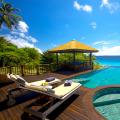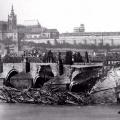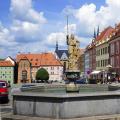
This excursion was planned as one of the mandatory points of the program active rest while in Cadaques.
Looking ahead: the surrounding natural landscapes amaze with their unusualness and dazzle ... After what he saw, the work of S. Dali becomes much more understandable.
════ ══
ROUTE
════ ══
Lately we have not taken maps with us. Our assistant is the OSMAND navigator application installed on the long-playing smart THL5000, which has a very detailed maps well adapted to hiking.
The route was divided into 2 different parts so as not to follow the same path:
- there: along the "goat" trails - the navigator counted about 7 km
- back: on the highway - about 8 km
On the Internet, you can find the opinion that the road is difficult and it is better to use transport (a tourist train must go). But I do not agree with this, because you will not get the full range of impressions from outlandish views. National park and the Cap de Creus nature reserve.
Judge for yourself: in our group there were participants over 60 and everything went smoothly. True, the campaign took place in early January. They took with them only water and dried fruits. And on the cape itself you can rest and refresh yourself.
Here is just one episode (100m to the top of the cape), when some were missing two limbs:

The whole journey took about 6 hours: with not very fast walking and shooting. We spent about an hour at the cape itself and at the Cap de Creus restaurant.
════ ═ ═ ═ ═ ══
Surreal landscapes and bizarre cliffs
════ ═ ═ ═ ═ ══
Silhouettes or skeletons of unknown creatures, or rocks, or huge pieces of Maasdam cheese ... If you enlarge the photo, you will clearly see a porous structure that is very uncharacteristic of rocks:



Just before the cape, a few more strange pictures awaited us: the color combinations seemed incredible: light, ashy, black, brown and even yellow! It is precisely such porous yellowish objects that can be found in Dali's paintings.


And here are the views from the cape. To look at them calmly, you have to throw on hoods. As some argue, it is these mesmerizing landscapes and uncompromising winds that can turn brains in a sur-direction ...

We were at the Dalí Theater-Museum in Figueres, we were at his house in Port Ligat. Now we see a profile everywhere ... or it seemed to us:

Halt at the top. Cap de Creus lighthouse and restaurant
════ ═ ═ ═ ═ ══
Stone mushrooms:

Lunar views, the Spaniards themselves also call this place "the end of the world":

By the way, there is a restaurant here:


An exotic, harsh and even brutal place for a restaurant. Stunning views and amazing wind, but you can find places on the leeward side or you can hide in the building. We got a table from a Singer sewing machine :)
The audience is predominantly French. For some reason, we were sure that prices would bite in such a place, but everything turned out to be quite divine. Ordered three cappuccino and two tortillas (sort of like an omelet) cost us less than 15 €. There was also WiFi. The only complaint is that there was no toilet paper in the restroom.

════ ══
BACK
════ ══
The return road (along the highway), despite the long length, took much less time, and impressed us no less:


At times, 3G connection was lost, at times it was switched to a French operator.
The feeling that they landed on another planet did not leave. But I am absolutely sure that all this will impress you live to a much greater extent.

════ ═ ═══ ══
Tired but happy
════ ═ ═══ ══
But the topic of Dali for today is not over for us yet. After walking for many hours, we were hungry enough to fully taste the delicious dishes in the legendary restaurant
We didn’t even plan to go to the cape, looking at sites on the Internet, I thought that there were boring landscapes, compared to the lush greenery of the Costa Brava. But being in Cadaqués, at the last moment they decided to go anyway.


Drive from Cadaques by car for 20 minutes. We drove when the sun was setting, and the cape appeared before us in a golden hue. I think during the day, when the sun is shining, the water plays with flowers and the views are even more beautiful.

But even in spite of the setting sun, the color of the water remains turquoise.


Cap de Creus is a national volcanic park formed by repeated volcanic eruptions - Paleosian rocks, craters, grottoes and miraculous caves. Rocks eaten away by the wind sometimes resemble a lunar landscape. The rocks are blown by the tramontana wind. Its speed is 150 km / h and it is noticeable when you come to the park. It seems that it will simply be blown away by the wind.






All three primary elements are represented on the cape - water - a blue-turquoise sea, earth with an incredible texture of stone and air that can be inhaled at full power. Here, like nowhere else, you can feel closeness to nature. It was these places that inspired Dali to create his masterpieces, and he left a couple of paintings with views of the cape to the world.



It was on the Cap de Creus that a film based on Jules Verne's novel "A Dangerous Light at the End of the World" was filmed.



There is a cafe, a hotel where you can take a break in the heat, and there is a restaurant. All this is located on the top of the mountain, near the lighthouse. The views of the bays are breathtaking.


It is here that you want to linger, stand at the top, contemplate the landscapes, when the wind blows you from all sides with incredible power. When you watch the sun go down slowly, from which the shades of the mountains, water, sky change, and around the silence and the roar of the wind. I don’t know from what, but such a surge of strength is felt, the cape is some kind of incredibly energetic place. And I will say that during the entire trip to Catalonia, when we saw many cities, beautiful bays, cathedrals, etc., Cap de Creus was the most vivid impression.
On the border of sea and land in the easternmost point of Catalonia, Spain and the entire Iberian Peninsula in the Upper Empordà region, there is the Cap de Creus Natural Park (Parque Natural de Cap de Creus).
The park is huge, it includes the Cap de Creus peninsula, part of the Werder Bremen mountain range, several resort towns: Llansa, El Port de la Selva, La Selva de Mar, Cadaques. But above all, when they talk about the park, they mean the cape itself - Cap de Creus - only 13886 hectares in water and on land.
Whichever side you are driving - from the charming town of Cadaqués or from the more modern-looking resort of El Port de la Selva - the road follows a completely intrepid serpentine road among blocks of solidified lava and terraces fortified with small stones with olive trees. These "steps" were built not for convenience, but primarily to delay soil erosion - the scourge of the entire Spanish coast.
Gradually, the "cultural" landscape gives way to completely wild thickets of some Mediterranean shrubs and alien lava fields, and finally, after driving along a narrow isthmus, we find ourselves on a cape.
The lighthouse has a small museum dedicated to the nature park and an information center. There are a couple of small cafes nearby.
V information center you can take a diagram of the park paths laid along the most beautiful places... But, unfortunately, the markings are not very good, where the paths are sometimes completely incomprehensible, so the scheme is needed first of all to learn about interesting places and roughly understand which way to go.
Many people do not even try to look for trails - they just drive to the lighthouse, take a few photos, go to a cafe, and drive back. And in the summer they try to quickly find a cozy bay and retire in it. Which, however, turns out badly: the coastal thickets at the height of the season resemble Moscow parks on a nice Sunday afternoon.
Don't want to spoil the experience - don't go to the park in July or August, especially on weekends.
More information about Cap de Creus can be found on the official site for Natural Parks of Catalonia. There you can also download a brochure describing all the parks in the region.
How to get to the Cap de Creus Natural Park
Usually navigators, if they "score" this park, lead exactly to the cape. It will not be difficult to find it on the map either - it protrudes strongly into the sea. From neighboring Cadaques or El Port de la Selva, small signs lead to the lighthouse. It is almost impossible to get lost, because there is no special variety of roads - you just need to go along the main road. From the French border to these places - about 26 kilometers, from Cadaques - about 8.
There is a medium sized car park next to the lighthouse. They say that there are no places there during the peak season. There are also several small parking lots along the road, before reaching the lighthouse. All these places are unguarded and free.
If you have time, you can walk to the cape, according to the signs, from Cadaques on foot - the road is incredibly beautiful and passes by the bays that are not visible from the car window.
If you leave the cape, you can see many more interesting things in the park. For example, the medieval one, built high in the mountains above the city of El Port de la Selva.
When you are going to the Cap de Creus, dress warmly: the strongest wind, the legendary tramontana knocks people down and almost blows away cars.
Cap de Creus, at the same time the peninsula and the cape bear this name - the most east point Spain. In 1998, these territories were declared national reserve, the province received a powerful boost for the development of tourism in the region.
Despite the fact that the Costa Brava is the most popular beach tourist destination in Spain among Russians, few people have the slightest idea of the place, preferring to lie down on the beach. Cap de Creus definitely deserves attention, so I recommend adding a visit to the reserve to add to your vacation.
Topical question - What to watch here? The entire peninsula, especially its coastline, has a landscape atypical for the Costa Brava. Under the influence of a strong north wind, called Tramuntana, an amazing unearthly relief has been formed here for thousands of years. There are absolutely no trees on the rocky terrain, weathered rocks take on bizarre shapes and color shades. Inaccessible bays complete the picture Mediterranean Sea with turquoise water. Lovers of beautiful scenery and nature should definitely visit and appreciate the Cap de Creus.
How to get to Cap de Creus
Geographically, the cape is located in the north-east of Spain in the autonomous community of Catalonia. Nearest Big City with international airport- Girona, the nearest tourist town to the Costa Brava -.
Cape Rap de Creus cannot boast of worldwide fame and such global popularity as, for example, the neighboring one. It is visited mainly by the Spaniards, respectively, the availability of the reserve by public transport limited.
By public transport
It is impossible to get directly to Cap de Creus by bus or train. If you are traveling without a car, then first you should get to Cadaques. How to do it from Barcelona, Girona and other cities is written. This city will be the starting point on the upcoming route to the most eastern point of Spain.
In Cadaqués, the 7 km long hiking trail to Cap de Creus begins. I will tell you about him in all the details further.
By car
If you have a rented car at your disposal, then all logistical problems disappear by themselves. In this case, you can easily and, most importantly, quickly get to Cadaqués, and then decide: leave the car in the parking lot in the city and go along the hiking route along the coast to Cap de Creus, or go straight to the observation deck, from where the most beautiful picture opens. ...
Cape Cap de Creus viewpoint
I'll start from the end of our trip, i.e. directly from the cape itself.
The best way to assess the scale and features of this place will be from aerial photography. View of the lighthouse and the Cap de Creus from different points:
On the livability and accessibility of visiting: s There are absolutely no questions here, the territory is perfectly prepared for the visit of a large number of tourists. There is a restaurant, free toilets. Two parking lots: one below, the other above, right next to the lighthouse.
Mediterranean sea views... They are incredible. A stunning contrast between the blue and turquoise shades of the water and the bizarre rock formations of the Cap de Creus.
Unlike the observation deck at Cape da Roca in Portugal, there is a lot of space here. You can safely step aside and make hundreds beautiful photos without jostling with other tourists.
The area around Cap de Creus. We were pleasantly surprised by the surroundings near the cape. From the lighthouse you can go absolutely in all directions. There are almost no insurmountable cliffs or thickets. If desired, in some places you can go down to the water.
And finally, some more aerial footage of Cap de Creus and its surroundings.
 How much time should be allocated directly to the observation deck itself and its surroundings? An ambiguous question. At the very least, you need to devote at least an hour. This will be enough to walk and take pictures of Cap de Creus without haste. As a maximum, you can spend half a day here if you wish. Wander for a couple of hours through the rocky landscape, go down to the water, dine in a restaurant with an excellent view of the sea.
How much time should be allocated directly to the observation deck itself and its surroundings? An ambiguous question. At the very least, you need to devote at least an hour. This will be enough to walk and take pictures of Cap de Creus without haste. As a maximum, you can spend half a day here if you wish. Wander for a couple of hours through the rocky landscape, go down to the water, dine in a restaurant with an excellent view of the sea.
Hiking trail to Cap de Creus
I definitely prefer to walk on hiking trails in nature reserves, not limited only to the main ones. viewing platforms... It takes much more time and effort, but, as a rule, you will come across incredibly beautiful quiet and secluded places along the way. This was the case when we visited.
When visiting Cape de Creus, we left the car in Cadaqués and walked a 7-kilometer route along the coast (14 km in two directions.)
The map is presented below:
 As you can see from the map, hiking is not circular. We go there one way, we return the same way. There are no large differences in elevation, and there are no dangerous areas. The route to the first end (from Cadaques to Cap de Creus) takes 2.5 - 3 hours, this time with stops in the photo. It is quite possible to get back in 2 hours.
As you can see from the map, hiking is not circular. We go there one way, we return the same way. There are no large differences in elevation, and there are no dangerous areas. The route to the first end (from Cadaques to Cap de Creus) takes 2.5 - 3 hours, this time with stops in the photo. It is quite possible to get back in 2 hours.
Now I will go through the key points of interest that come across on the way.
We pass Cadaques, Port Ligat and go out onto an unpaved path. This is where the marked route begins. The road rushes through thickets and olive groves. The surrounding area is private property.
The site is the simplest, sometimes even boring. The road runs far from the sea.
An hour later, the private property ceases to be seen, the path is gradually gaining height and a pretty picture begins to emerge.
A very memorable place, located about half the way to Cap de Creus. It is very simple to define it, this is the most high point above sea level while hiking (not counting the cape itself). Actually, the panorama from here is appropriate.
The second half of the route is more interesting, visually more impressive.
Only a couple of hours later, already near the Cap de Creus, the trail first goes straight to the sea, a small cove with a sandy shore.
This is the only place where you can swim during the entire 3 hour hike. To be honest, the beach looks beautiful only from above. In fact, it is small and a lot of grass. In general, the entire coast near the cape is not swimable. The beaches of Cadaques are generally a swamp. It is worth going here for the beautiful views and panoramas.
Summing up my impressions of the route from Cadaques to Cap de Creus, I will say that the sensations are ambiguous. The first part of the path is not impressive, really beautiful views start to open only after 1.5 hours of travel. Another disadvantage is that there and back you have to go along the same path.
I personally enjoyed hiking, but I love this kind of activity. I recommend taking this route to the Cap de Creus if you really enjoy hiking, which involves some decent cardio.
We passed this route in early May and even then, at +20, it was quite difficult. There is absolutely no shadow on the terrain, and occasionally one can come across tiny trees and bushes. Therefore, I think it's not worth prying here in the summer at +35.
Just two hours from Barcelona, on the Costa Brava, near the town of Figueres, where Salvador Dali was born, there is a truly unearthly place - Cap de Creus or Cape Creus. This is the easternmost point of the peninsula, and it is worth going here for inspiration and a sense of blessed perfection.
It's shrill here blue waters The Mediterranean seas touch the stone dance of the frozen rock, and the golden-emerald palette of plants blooming on the cape in the warm season turns the austere coastal landscape into a kind of patterned oriental carpet.
In the photo: Cape Creus, Catalonia, photo by Boris Paltusov
After taking just a couple of sips of salty air, you begin to feel an incredible sense of freedom and you understand that it is not for nothing that the Catalans consider Cape Creus a magical place of power. If you take a chance and make your way along narrow, steep paths to the bays, you can see flocks of shiny fish flashing in the water, embossed red corals and lazy sea urchins.

Alien landscape of Cape Creus, photo by Boris Paltusov
The alien nature of the landscape is largely determined by Tranmontana - the harsh north wind, whose destructive impulses sometimes reach 150 km per hour. Today Cap de Creus - national park and the "Parc natural del cap de Creus" reserve, which includes about 14,000 hectares of volcanic cliffs and sea bays.

In the photo: volcanic rocks, photo by Boris Paltusov
Special footpaths are laid along the multi-kilometer coastline, they wind between rock ledges and clear water bays. The path is quite difficult, therefore for a walk you need comfortable shoes and good physical fitness, and only 25 km from this place is the French border and the East Pyrenees begins.

However, Cape Creus attracts not only lovers of alien landscapes, but also people who are not alien to art, because it was Cap de Creus who often depicted the great Salvador Dali on his canvases, for example, in the painting "The Great Masturbator" you can see the silhouette of a rock on Cape Creus.

The cliff that inspired Dali to paint the painting "The Great Masturbator", photo by Mikhail Shugaev
“The most important principle of my theory of paranoid metamorphosis is embodied here in rock granite. These are frozen clouds reared by the explosion in all their innumerable forms, more and more new - you just need to slightly change the angle of view, "said the artist.

In the painting by Salvador Dali "The Great Masturbator" you can see the silhouette of a rock on Cape Creus
It was in the bizarre shapes of the Paleozoic rocks that Dali found absurd images for his future works. However, the entire artistic world of Dali, to one degree or another, grew out of love for his native land, for its colors and light, and a two-three hour walk in nature reserve- this is a unique opportunity not only to see a very special flora and fauna, but to visually and tangibly feel the symbolism of Dali's works.

Space rocks at Cape Creus, photo by Boris Paltusov
Layered rocks, geological faults, craters, caves and grottoes of Cape Creus "posed" not only for Dali, but also for Picasso and Gaudi. “This is exactly the place where the Pyrenees descend to the sea in grandiose geological madness to die in it,” Dali wrote about Cap de Creus.

Salvador Dali "Nude Figures at Cape Creus"
Locals often call Cape Creus the End of the World. Rocky bays are fraught with many dangers for sea-going ships, it is not without reason that the film "Dangerous Light at the End of the Earth" based on the novel by Jules Verne was filmed here in the seventies.

The bays near Cape Creus are fraught with many dangers for ships, photo by Boris Paltusov
The observation tower on a high cliff was built in 1853, but the lighthouse has existed since time immemorial, according to legend it was built by the legendary Hercules himself. This is a meeting place for lovers of beauty - Catalans and French often come here on weekends, just to admire the amazing beauty of the sunrises.

Photo: Cape Creus - the best place to admire
sunsets and sunrises, photo: Boris Paltusov
Yes, Cape Creus is one of the best places on earth to meet the dawn of a new day or admire the sunset: the pacified sea, like a mirror, reflects the sky shimmering with all the colors of watercolors, and one involuntarily gets the feeling that the past and the future have come together in this place to dissolve into the endless horizon. As far as the eye can reach - rocks, sky and water. In such places, you really feel that time passes at a different speed, and sometimes it seems that it has completely stopped its run.
Text and photo: Polina Dobrogaeva




